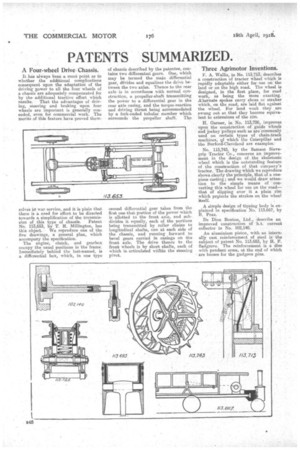PATENTS SUMMARIZED.
Page 22

If you've noticed an error in this article please click here to report it so we can fix it.
A Four-wheel Drive Chassis.
It has always been a moot point as to whether the additional complications consequent upon the adaptation of the driving power to all the four wheels of a chassis are adequately compensated for by the additional tractive effort which results. That the advantages of driving, steering and braking upon four wheels are important is generally conceded, even for commercial work. The merits of this feature have proved them selves irf war service, and it is plain that there is a need for effort to be directed towards a, simplification of the transmis sion of this type of chassis. Patent No. 113,653, by T. H. Millington, has this object. We reproduce one of the five drawings, a general plan, which accompany the specification. The engine, clutch, and gearbox occupy the usual positions in the frame. Immediately behind the last-named, is a differential box, which, in one type of ehassis described by the patentee, contains two differential gears. One, which may be termed the main differential gear, divides and equalizes the drive betiveert the two axles. Thence to the rear axle -is in accordance with normal construction, a propeller-shaft transmitting the power to a differential gear in the rear axle casing, and the torque-reaction and driving thrust being accommodated by a fork-ended tubular member which surrounds the propeller shaft. The eecond differential gear takes from the first one that, portion of the power which is allotted to the front axle, and subdivides it equally, each of the portions being transmitted by roller chains to longitudinal shafts, one at each side of the chassis, and running forward to bevel gears carried in casings on the front axle. The drive thence to the front wheels is by short shafts, each of which is articulated within the steering pivot.
Three Agrimotor Inventions.
F. A. Wallis, in No. 113,713, describes a construction of tractor wheel which is rapidly adaptable either for use on the land or on the high road. The wheel is designed, in the first place, for road work, as being the more exacting. Alternate spokes carry shoes or stzakes which, on the road, are laid flat against the wheel. For land work they are swung out so that they become equivalent to extensions of the rim.
H. Garner, in No. 113,726, improves upon the construction of guide wheels and jockey pulleys such as are commonly used on certain types of chain-,track machines, f which the Caterpillar and the Burford-Cleveland are examples.
No. 113,743, by the Samson Sievegrip Tractor Co., concerns an improvement in the design of the skeletonic wheel which is the outstanding feature of the construction of that company's tractor. The drawing which we reproduce shows clearly the principle, that of a onepiece casting; and we would draw attention to the simple means of converting this wheel for use on the road— that of slipping over it a, plain rim which prgtects the strakes on the wheel A simple design of tipping body is explained in specification No. 113,667, by B. Prax.
De Dion Houton, Ltd., describe an improved construction of ht. current collector in No. 102,140.
An aluminium piston, with an internally cast reinforcement of steel is the subject of patent No. 113,683, by H. F. Sadgrove. The reinforcement is a disc with pendant arms, at the end of which are bosses for the gudgeon pins.






















